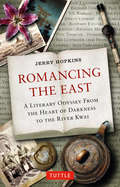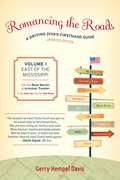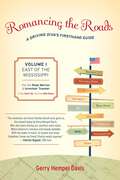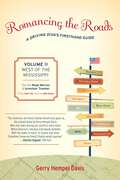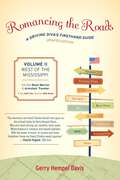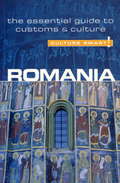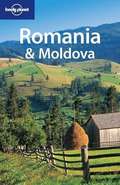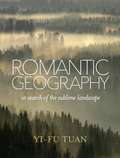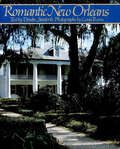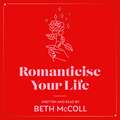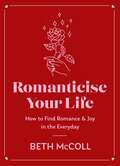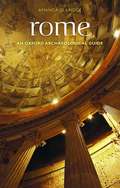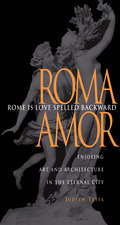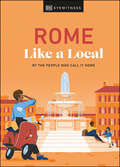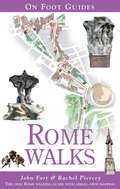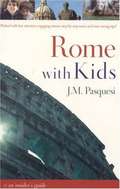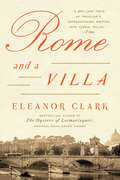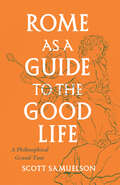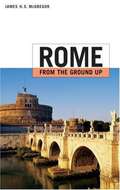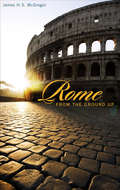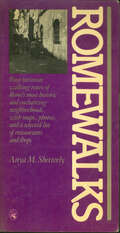- Table View
- List View
Romancing the East
by Jerry HopkinsFrom the time of Marco Polo's trek across the Central Asian desert to the empire of the mighty Kahn, no other place on earth, not the languid South Pacific or even deepest, darkest Africa has so challenged and enchanted the Western imagination as have the fabled lands of the East!However soaked in blood its history and no matter how unsettling its social conditions and poverty, Asia has never lost its irresistible attraction or mystic. Asia has long been an inspiration for Western novelists, so much so that more than 5000 novels have been set in Asia in the English language alone. Storied names like Rudyard Kipling, Joseph Conrad, Pearl S. Buck, George Orwell, Graham Greene, E.M. Forster and many more have used their experiences in Asia as a vibrant backdrop for some of the world's most famous works of literature.In Romancing the East, best-selling author Jerry Hopkins combines his research and his own experiences as a longtime expatriate with an intimate knowledge of Asia in offering us a unique perspective on the impact of Eastern culture in Western literature.
Romancing the Roads: A Driving Diva's Firsthand Guide, East of the Mississippi
by Gerry Hempel DavisThis newly updated compendium of facts, observations, discoveries, reviews, serendipities, humor, experiences, and more is not only for the road traveler, but the armchair traveler as well. It reads not as a phone directory but more as a shared diary of discoveries along America's highways and byways. Unless otherwise noted, the author has visited every place mentioned, from Bud's Discount Center in Jasper, Alabama to the Waldorf Astoria hotel in New York. Even if you never get in the car and discover such wonders for yourself, you will enjoy this vicarious journey to places both sublime and ordinary as the author makes her way from Maine to Florida and west to the Mississippi River.
Romancing the Roads: A Driving Diva's Firsthand Guide, East of the Mississippi
by Gerry Hempel DavisThis compendium of facts, observations, discoveries, reviews, serendipities, humor, experiences, and more is not only for the road traveler, but the armchair traveler as well. It reads not as a phone directory but more as a shared diary of discoveries along America's highways and byways. Unless otherwise noted, the author has visited every place mentioned, from Bud's Discount Center in Jasper, Alabama to the Waldorf Astoria hotel in New York. Even if you never get in the car and discover such wonders for yourself, you will enjoy this vicarious journey to places both sublime and ordinary as the author makes her way from Maine to Florida and west to the Mississippi River.
Romancing the Roads: A Driving Diva's Firsthand Guide, West of the Mississippi
by Gerry Hempel DavisThis compendium of facts, observations, discoveries, reviews, serendipities, humor, experiences, and more is not only for the road traveler, but the armchair traveler as well. Unlike typical guides, which read more like phone directories, Romancing the Roads is a shared diary of discoveries along America's highways and byways. Join Gerry on a tour of hotels, B & B's, restaurants, national parks, antique stores, consignment shops, boutiques, and little-known places that make America such a great place for road-tripping. Unless otherwise noted, the author has visited every place mentioned, from the ostrich farm along Interstate 10 in Arizona to the Biltmore hotel in Los Angeles. Even if you never get in the car and discover such wonders for yourself, you will enjoy this vicarious journey to places both sublime and ordinary as the author makes her way from Washington to California and east to the Mississippi River.
Romancing the Roads: A Driving Diva's Firsthand Guide, West of the Mississippi
by Gerry Hempel DavisThis updated compendium of facts, observations, discoveries, reviews, serendipities, humor, experiences, and more is not only for the road traveler, but the armchair traveler as well. Unlike typical guides, which read more like phone directories, Romancing the Roads is a shared diary of discoveries along America's highways and byways. Join Gerry on a tour of hotels, B & B's, restaurants, national parks, antique stores, consignment shops, boutiques, and little-known places that make America such a great place for road-tripping. Unless otherwise noted, the author has visited every place mentioned, from the ostrich farm along Interstate 10 in Arizona to the Biltmore hotel in Los Angeles. Even if you never get in the car and discover such wonders for yourself, you will enjoy this vicarious journey to places both sublime and ordinary as the author makes her way from Washington to California and east to the Mississippi River.
Romania - Culture Smart!
by Debbie StoweCulture Smart! provides essential information on attitudes, beliefs and behavior in different countries, ensuring that you arrive at your destination aware of basic manners, common courtesies, and sensitive issues. These concise guides tell you what to expect, how to behave, and how to establish a rapport with your hosts. This inside knowledge will enable you to steer clear of embarrassing gaffes and mistakes, feel confident in unfamiliar situations, and develop trust, friendships, and successful business relationships.Culture Smart! offers illuminating insights into the culture and society of a particular country. It will help you to turn your visit-whether on business or for pleasure-into a memorable and enriching experience. Contents include* customs, values, and traditions* historical, religious, and political background* life at home* leisure, social, and cultural life* eating and drinking* dos, don'ts, and taboos* business practices* communication, spoken and unspoken"Culture Smart has come to the rescue of hapless travellers." Sunday Times Travel"... the perfect introduction to the weird, wonderful and downright odd quirks and customs of various countries." Global Travel"...full of fascinating-as well as common-sense-tips to help you avoid embarrassing faux pas." Observer"...as useful as they are entertaining." Easyjet Magazine"...offer glimpses into the psyche of a faraway world." New York Times
Romania and Moldova
by Steve Kokker Cathryn KempDetailed coverage is given of the magnificent Carpathians and Dracula's homeland, Transylvania.
Romantic Geography
by Yi-Fu TuanGeography is useful, indeed necessary, to survival. Everyone must know where to find food, water, and a place of rest, and, in the modern world, all must make an effort to make the Earth--our home--habitable. But much present-day geography lacks drama, with its maps and statistics, descriptions and analysis, but no acts of chivalry, no sense of quest. Not long ago, however, geography was romantic. Heroic explorers ventured to forbidding environments--oceans, mountains, forests, caves, deserts, polar ice caps--to test their power of endurance for reasons they couldn't fully articulate. Why climb Everest? "Because it is there. " Yi-Fu Tuan has established a global reputation for deepening the field of geography by examining its moral, universal, philosophical, and poetic potentials and implications. In his twenty-second book, Romantic Geography, he continues to engage the wide-ranging ideas that have made him one of the most influential geographers of our time. In this elegant meditation, he considers the human tendency--stronger in some cultures than in others--to veer away from the middle ground of common sense to embrace the polarized values of light and darkness, high and low, chaos and form, mind and body. In so doing, venturesome humans can find salvation in geographies that cater not so much to survival needs (or even to good, comfortable living) as to the passionate and romantic aspirations of their nature. Romantic Geography is thus a paean to the human spirit, which can lift us to the heights but also plunge us into the abyss.
Romantic New Orleans
by Deidre StanforthFounded to serve as the capital of France's vast overseas empire, New Orleans has gone on to survive wars, invasions, floods, hurricanes, plagues, fires, and financial panics. Today it is a romantic city of secret gardens, handsomely restored mansions, murmuring fountains, legendary ghosts, Creole cuisine, and hot jazz. Both sin and saintliness, high-life and low, flourish under tropical skies; and its centuries-long flirtations with disaster have given its people a reckless, pleasure-loving philosophy that is acted out in its streets and squares, courtyards and terraces.New Orleans's colorful atmosphere and strange history are magnificently captured in this handsome volume-a tour not only of the famous sights but also of the many places tourists seldom see. Here, too, are the stories of the heroes and the villains, great ladies and prostitutes, who have inhabited the city's curiously ornamented buildings-and of the phantoms that haunt those buildings still. The text is illustrated by superb photographs reproducing all of New Orleans beauty, from the serenity of the surrounding plantations and bayous to the French Quarter, the riverfront, the celebrated restaurants, and the mad excitement of Mardi Gras. Romantic New Orleans is a portrait of a unique city, drenched in history, which seems miraculously to have returned from the whirlpool of time.
Romanticise Your Life: How to find joy in the everyday
by Beth McColl'Romanticise Your Life came at a time when I really needed it. Beth's writing has helped me to discover the joy all around me' - ANNIE LORD, author of NOTES ON HEARTBREAKExploring all areas of life from solo travelling to the joy of friendships, tapping into your Main Character Energy, and taking control of your dating life, in this beautifully illustrated must-have guide Beth McColl shows you how romance is about appreciating the small things, because they can be just as magnificent as meeting the love of your life.Everyday romance might be:· Cooking yourself an elaborate meal· Going on a solo trip to the seaside· Writing a letter to an old friend · Texting someone out of the blue just to let them know you're missing them· Smiling at a handsome stranger on the train just before your stopEmpowered by Beth's uplifting anecdotes and inspiring tips, you will discover that whether it's a grand gesture, or just simply appreciating how the sun rises anew each day, life is about making the most of the moments we're given...Because joy and romance start with you.
Romanticise Your Life: How to find joy in the everyday
by Beth McColl'Romanticise Your Life came at a time when I really needed it. Beth's writing has helped me to discover the joy all around me' - ANNIE LORD, author of NOTES ON HEARTBREAKExploring all areas of life from solo travelling to the joy of friendships, tapping into your Main Character Energy, and taking control of your dating life, in this beautifully illustrated must-have guide Beth McColl shows you how romance is about appreciating the small things, because they can be just as magnificent as meeting the love of your life.Everyday romance might be:· Cooking yourself an elaborate meal· Going on a solo trip to the seaside· Writing a letter to an old friend · Texting someone out of the blue just to let them know you're missing them· Smiling at a handsome stranger on the train just before your stopEmpowered by Beth's uplifting anecdotes and inspiring tips, you will discover that whether it's a grand gesture, or just simply appreciating how the sun rises anew each day, life is about making the most of the moments we're given...Because joy and romance start with you.
Romanticise Your Life: How to find joy in the everyday
by Beth McColl'Romanticise Your Life came at a time when I really needed it. Beth's writing has helped me to discover the joy all around me' - ANNIE LORD, author of NOTES ON HEARTBREAKExploring all areas of life from solo travelling to the joy of friendships, tapping into your Main Character Energy, and taking control of your dating life, in this beautifully illustrated must-have guide Beth McColl shows you how romance is about appreciating the small things, because they can be just as magnificent as meeting the love of your life.Everyday romance might be:· Cooking yourself an elaborate meal· Going on a solo trip to the seaside· Writing a letter to an old friend · Texting someone out of the blue just to let them know you're missing them· Smiling at a handsome stranger on the train just before your stopEmpowered by Beth's uplifting anecdotes and inspiring tips, you will discover that whether it's a grand gesture, or just simply appreciating how the sun rises anew each day, life is about making the most of the moments we're given...Because joy and romance start with you.
Rome
by Spiro Kostof Rabun Taylor Rinne Katherine WentworthSpanning the entire history of the city of Rome from Iron Age village to modern metropolis, this is the first book to take the long view of the Eternal City as an urban organism. Three thousand years old and counting, Rome has thrived almost from the start on self-reference, supplementing the everyday concerns of urban management and planning by projecting its own past onto the city of the moment. This is a study of the urban processes by which Rome's people and leaders, both as custodians of its illustrious past and as agents of its expansive power, have shaped and conditioned its urban fabric by manipulating geography and organizing space; planning infrastructure; designing and presiding over mythmaking, ritual, and stagecraft; controlling resident and transient populations; and exploiting Rome's standing as a seat of global power and a religious capital.
Rome (Oxford Archaeological Guides)
by Amanda Claridge Tony Cubberley Judith TomsCapital and showcase of the Roman Empire and the center of Christian Europe, the city of Rome is the largest archaeological site in the world. In the new Second Edition of her popular handbook, Amanda Claridge again presents an indispensable guide to all significant monuments in Rome dating from 800 BC to 600 AD, including such breathtaking structures as the Capitoline Hill, the Roman Forum, the Colosseum, the Mausoleums of Augustus and Hadrian, the Circus Maximus, and the Catacombs. Featuring over 220 high-quality maps, site plans, diagrams, and photographs, the edition is divided into fourteen main areas, with star ratings to help you plan your visit in advance. The book also features glossaries of architectural terms, information about opening times, suggestions for further reading, and much more. The Second Edition has been extensively revised--the author has added more than 20 new sites and illustrations, re-organized and expanded the itineraries to suit the many changes that have taken place in the past decade, and fully updated the practical information.
Rome Is Love Spelled Backward: Enjoying Art and Architecture in the Eternal City
by Judith TestaA celebration of the art, architecture, and timeless human passion of the Eternal City, Rome Is Love Spelled Backward explores Rome's best-known treasures, often revealing secrets overlooked in conventional guidebooks. With the ancient play on "Roma" and "Amor"—ROMAMOR—Testa invites readers to experience the world's long love affair with one of its most beautiful cities.
Rome Like a Local: By the People Who Call It Home (Local Travel Guide)
by DK Eyewitness Liza Karsemeijer Emma Law Federica Rustico Andrea StrafileKeen to explore a different side of Rome? Like a Local is the book for you.This isn&’t your ordinary travel guide. Beyond Rome&’s iconic ancient ruins are hidden street food haunts, buzzing aperitivo spots and scenic walks that locals love – and that&’s where this book takes you. Turn the pages to discover:The small businesses and community strongholds that add character to this vibrant city, recommended by true locals6 themed walking tours dedicated to specific experiences such as fashion and cinematic history A beautiful gift book for anyone seeking to explore RomeHelpful what3word addresses, so you can pinpoint all the listed sightsCompiled by four proud Romans, this stylish travel guide is packed with Rome&’s best experiences and secret spots, handily categorized to suit your mood and needs.Whether you&’re a restless Roman on the hunt for a new hangout, or a visitor keen to discover a side you won&’t find in traditional guidebooks, Rome Like A Local will give you all the inspiration you need. About Like A Local:These giftable and collectable guides from DK Eyewitness are compiled exclusively by locals. Whether they&’re born-and-bred or moved to study and never looked back, our experts shine a light on what it means to be a local: pride for their city, community spirit and local expertise. Like a Local will inspire readers to celebrate the secret as well as the iconic – just like the locals who call the city home. Looking for another guide to Rome? Explore further with our DK Eyewitness or Top 10 guides to Rome.
Rome Walks (On Foot Guides)
by John Fort Rachel PierceyExplore Rome on foot with the help of this innovative guide, filled with full-color, aerial-view maps and color photographs. The routes are comprehensive but not overwhelming, allowing you to connect neighborhoods, parks, and noteworthy sights at your own pace.
Rome With Kids: An Insider's Guide
by J. M. PasquesiAward winning Rome with Kids is a complete travel guide, with or without kids! A guide for exploring Rome with children.
Rome and a Villa
by Eleanor ClarkIn 1947 a young american woman named Eleanor Clark went to Rome on a Guggenheim fellowship to write a novel. But Rome had its way with her, the novel was abandoned, and what followed was not a novel but a series of sketches of Roman life, most written between 1948 and 1951. This new edition of her now classic book includes an evocative foreword by the eminent translator William Weaver, who was a close friend of the author's and often wandered the city with her during the years she was working on Rome and a Villa. Once in Rome, the foreign writer or artist, over the course of weeks, months, or years, begins to lose ambition, to lose a sense of urgency, to lose even a sense of self. What once seemed all-consuming is swallowed up by Rome&$8212;by the pace of life; by the fatalism of the Roman people, to whom everything and nothing matters; by the sheer historic weight and scale of the place. Rome is life itself—messy, random, anarchic, comical one moment, tragic the next, and above all, seductive. Clark pays special attention to Roman art and architecture. In the book's midsection she looks at Hadrian's Villa—an enormous, unfinished palace—as a metaphor for the city itself: decaying, imperial, shabby, but capable of inducing an overwhelming dreaminess in its visitors. The book's final chapter, written for an updated edition in 1974, is a lovely portrait of the so-called Protestant cemetery where Keats, Shelley, and other foreign notables are buried.
Rome and a Villa
by Eleanor ClarkIn 1947 a young american woman named Eleanor Clark went to Rome on a Guggenheim fellowship to write a novel. But Rome had its way with her, the novel was abandoned, and what followed was not a novel but a series of sketches of Roman life, most written between 1948 and 1951. This new edition of her now classic book includes an evocative foreword by the eminent translator William Weaver, who was a close friend of the author's and often wandered the city with her during the years she was working on Rome and a Villa.Once in Rome, the foreign writer or artist, over the course of weeks, months, or years, begins to lose ambition, to lose a sense of urgency, to lose even a sense of self. What once seemed all-consuming is swallowed up by Rome&$8212;by the pace of life; by the fatalism of the Roman people, to whom everything and nothing matters; by the sheer historic weight and scale of the place. Rome is life itself--messy, random, anarchic, comical one moment, tragic the next, and above all, seductive.Clark pays special attention to Roman art and architecture. In the book's midsection she looks at Hadrian's Villa--an enormous, unfinished palace--as a metaphor for the city itself: decaying, imperial, shabby, but capable of inducing an overwhelming dreaminess in its visitors. The book's final chapter, written for an updated edition in 1974, is a lovely portrait of the so-called Protestant cemetery where Keats, Shelley, and other foreign notables are buried.
Rome and a Villa
by Eleanor ClarkIn 1947 a young american woman named Eleanor Clark went to Rome on a Guggenheim fellowship to write a novel. But Rome had its way with her, the novel was abandoned, and what followed was not a novel but a series of sketches of Roman life, most written between 1948 and 1951. This new edition of her now classic book includes an evocative foreword by the eminent translator William Weaver, who was a close friend of the author's and often wandered the city with her during the years she was working on Rome and a Villa.Once in Rome, the foreign writer or artist, over the course of weeks, months, or years, begins to lose ambition, to lose a sense of urgency, to lose even a sense of self. What once seemed all-consuming is swallowed up by Rome&$8212;by the pace of life; by the fatalism of the Roman people, to whom everything and nothing matters; by the sheer historic weight and scale of the place. Rome is life itself--messy, random, anarchic, comical one moment, tragic the next, and above all, seductive.Clark pays special attention to Roman art and architecture. In the book's midsection she looks at Hadrian's Villa--an enormous, unfinished palace--as a metaphor for the city itself: decaying, imperial, shabby, but capable of inducing an overwhelming dreaminess in its visitors. The book's final chapter, written for an updated edition in 1974, is a lovely portrait of the so-called Protestant cemetery where Keats, Shelley, and other foreign notables are buried.
Rome as a Guide to the Good Life: A Philosophical Grand Tour
by Scott SamuelsonA unique, portable guidebook that sketches Rome’s great philosophical tradition while also providing an engaging travel companion to the city. This is a guidebook to Rome for those interested in both la dolce vita and what the ancient Romans called the vita beata—the good life. Philosopher Scott Samuelson offers a thinker’s tour of the Eternal City, rooting ideas from this philosophical tradition within the geography of the city itself. As he introduces the city’s great works of art and its most famous sites—the Colosseum, the Forum, the Campo de’ Fiori—Samuelson also gets to the heart of the knotty ethical and emotional questions they pose. Practicing philosophy in place, Rome as a Guide to the Good Life tackles the profound questions that most tours of Rome only bracket. What does all this history tell us about who we are? In addition to being a thoughtful philosophical companion, Samuelson is also a memorable tour guide, taking us on plenty of detours and pausing to linger over an afternoon Negroni, sample four classic Roman pastas, or explore the city’s best hidden gems. With Samuelson’s help, we understand why Rome has inspired philosophers such as Lucretius and Seneca, poets and artists such as Horace and Caravaggio, filmmakers like Fellini, and adventurers like Rosa Bathurst. This eclectic guidebook to Roman philosophy is for intrepid wanderers and armchair travelers alike—anyone who wants not just a change of scenery, but a change of soul.
Rome from the Ground Up
by James H. S. McgregorBeginning with the ground on which Rome first rose, this book conjures past and present cities, conducting the reader through time and space to the complex and shifting realities--architectural, historical, political, and social--that constitute Rome.
Rome from the Ground Up (From The Ground Up #4)
by James H. McGregorRome is not one city but many, each with its own history unfolding from a different center: now the trading port on the Tiber; now the Forum of antiquity; the Palatine of imperial power; the Lateran Church of Christian ascendancy; the Vatican; the Quirinal palace. Beginning with the very shaping of the ground on which Rome first rose, this book conjures all these cities, past and present, conducting the reader through time and space to the complex and shifting realities—architectural, historical, political, and social—that constitute Rome. A multifaceted historical portrait, this richly illustrated work is as gritty as it is gorgeous, immersing readers in the practical world of each period. James H. S. McGregor’s explorations afford the pleasures of a novel thick with characters and plot twists: amid the life struggles, hopes, and failures of countless generations, we see how things truly worked, then and now; we learn about the materials of which Rome was built; of the Tiber and its bridges; of roads, aqueducts, and sewers; and, always, of power, especially the power to shape the city and imprint it with a particular personality—like that of Nero or Trajan or Pope Sixtus V—or a particular institution. McGregor traces the successive urban forms that rulers have imposed, from emperors and popes to national governments including Mussolini’s. And, in archaeologists’ and museums’ presentation of Rome’s past, he shows that the documenting of history itself is fraught with power and politics. In McGregor’s own beautifully written account, the power and politics emerge clearly, manifest in the distinctive styles and structures, practical concerns and aesthetic interests that constitute the myriad Romes of our day and days past.
Romewalks
by Anya M. ShetterlyThe secret of all cities is to be found in their streets and neighborhoods. This is especially true of Rome. What distinguishes this guidebook to Rome from so many others is that it explores neighborhoods instead of merely describing monuments. By taking the reader on walks through the streets around the Campo dei Fiori, the Piazza Noavona, the Jewish Ghetto, and Trastevere, and by paying close attention to architecture, local history and people, art, religion, archeology, and, of course, cuisine, Romewalks by Anya M. Shetterly offers a remarkably intimate and comprehensive look at the city and its history. Also included in this guidebook are maps of each of the four walks, photographs, a concise section of information and advice, a list of specially selected restaurants and shops, and an index.
